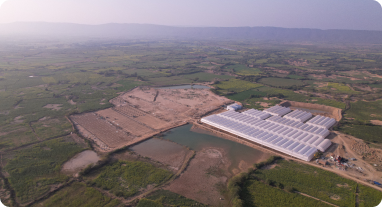Be an Agripreneur
Tax-Free Agri IncomeNo Operational DutiesHigh & Regular Returns
Area covered – 60 acres
Plants growing together – 682500
Annual Production – 9490 tonnes
Team Headcount – 350
Our Projects
Sustainable farming for a healthy planet
Towards a well-nourished world

- akashjanoriya788
- March 24, 2024
- 0 Comments
Patented Farming Tech
Devoid of traditional medium, our revolutionary growing chambers create optimum plant growth conditions.

- akashjanoriya788
- March 24, 2024
- 0 Comments
Utilising Barren Land
With the ability to build farms on barren land, we're able to put unusable land to productive use.

- akashjanoriya788
- March 24, 2024
- 0 Comments
Achievements & Awards
Featured on Forbes India's March 2023 "Innovation Special" & won National Startup Awards 2023 as Sustainability Champions.

- akashjanoriya788
- March 24, 2024
- 0 Comments
Utilising Barren Land
With the ability to build farms on barren land, we're able to put unusable land to productive use.

- akashjanoriya788
- March 24, 2024
- 0 Comments
Patented Farming Tech.
Devoid of traditional medium, our revolutionary growing chambers create optimum plant growth conditions.
Join as a farm partner

Tax-Free
Agri Income

No Operational
Duties

High & Regular
Returns

Long-Term
Asset Creation

The founders
Two IITians, Abhay Singh & Amit Kumar, started their research journey from a small rooftop in 2018. And today, they are connstructing hundreds of acres across the country as they envision a world in which high-quality vegetables are affordable and easily accessible to every individual, all year long.
Farm Partner Testimonials








Frequently Asked Questions
Instead of growing the vegetables/fruits in soil, when we grow plants either through soilless chambers or in a neutral medium like coconut coir, cocopeat, perlite, rockwool, expanded clay to hold roots of plants and dissolve all required nutrients in water and provide directly to plant, said method of growing is called Hydroponic farming.
These growing systems/mediums are susceptible to climatic conditions, hence we typically grow the plants in polyhouses with certain/complete climate control, hence depending on level of control we also classify our farms as “Protected Cultivation” to “Controlled Environment Agriculture”.
We are producing multiple varieties of tomatoes and cucumbers at a commercial level. The technology has successfully tested growing chillies, bell-peppers, egg-plants, okra and other vegetables and it will be suitably introduced in the next harvesting cycle.
Most hydroponic farms and vertical farms around the world are shutting down because many producers can successfully use technology to grow, but they don’t have the commercial side figured out. If they can grow produce, but are not able to sell or not able to sell to right people or not able to sell at right prices, in the long run they can not make the investment viable.
Our goal was to focus on access to high quality food, at industrial level productions, sell to the masses at regular market price and Tomatoes and cucumbers are crops that are consumed throughout India round the year. Since our focus is on growing the scale and having a huge quantity of production, we are focusing on crops that have a huge market, so we don’t have to spend effort and time building a separate supply network.
With our market studies, we have expanded our selection to eggplants, bell-peppers, okra and chillies etc. We also plan to grow exotic vegetables, salads, herbs, leafy greens and select fruits, however, since the size of that market is small, we will have limited production of such exotic veggies and fruits.
The technology is developed to house anywhere between 10,500 to 13,000 plants per acre. Depending on the specific variety of crop, type of crop and seasonality, we can expect a production of 2 kg/plant to 8 kg/plant and 2-3 cycles of every year. We always intend to optimise the production as well as average selling price, so we can produce maximum possible revenue per acre. For tomatoes, in lab settings, we have demonstrated 2 cycles per year with 90,000 Kgs/Acre of production per cycle. Large scale farms (after considering disease, harvesting and transport losses), we can have 120,000-140,000 Kgs/acres/year of production and these production levels are subject to type of varieties, seasonality and pricing in the market.
There are certain varieties which produce lesser production, but have much higher market rates. There are varieties which produce very huge quantities and are sold at market rates. Certain crops when grown in off-seasons can fetch 3-5 times its seasonal average selling price. Through market mapping, data analysis, non-seasonal growing, crop rotations and long term contracts, EEKI optimise and maximise the revenue per acre.
In a stabilised market, 40-50% of produce will be sold in biggest mandis across tier-1 and tier-2 cities, 20-25% produce will be sold to organised retail chains/B2B clients, 10-15% produce will be exported and 10-15% of produced will be sold to retail customers under EEKI’s own brand.





















